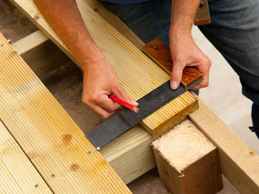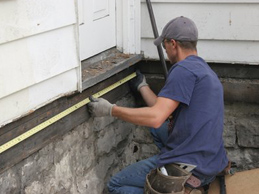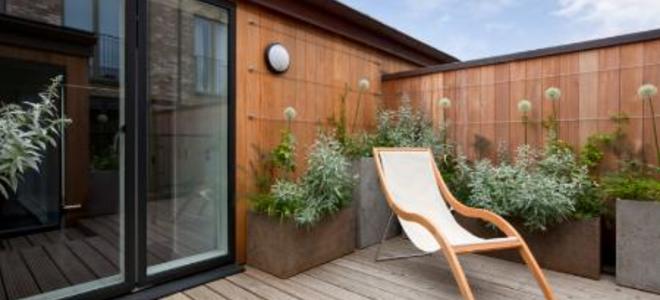How to Build a Deck: Step by Step
What you need:
 2×6 decking 2×8 joists measuring tape post hole digger hammer drill hand sledge rebar mason’s level framing square stringline concrete post base anchors joist hangers bolts and washers hammer bench top planer 120 grit sandpaper router drill Forstner bit 2.5 inch deck screws
2×6 decking 2×8 joists measuring tape post hole digger hammer drill hand sledge rebar mason’s level framing square stringline concrete post base anchors joist hangers bolts and washers hammer bench top planer 120 grit sandpaper router drill Forstner bit 2.5 inch deck screws
A well-made deck can be a hugely popular addition to your home, but there’s also a huge list of things to consider to make sure you get the job done right.
This guide will offer some basic instructions on how to build a generic 12×20-foot deck, including the preliminary elements with a foundation of concrete piers, and steel reinforcement set in soil, using 2×8 joists and 2×6 decking.
Step 1 – Review the Preliminaries
Legally speaking, you may be required to produce sketches or get a special permit before taking on a build of this size. Start by checking with both your building department and homeowners association to see what, if any, requirements they may have. Usually a sketch with top and side views of the deck and foundation is adequate, but they may ask for dimensional relationship to your house and “set back” lines.
Set back lines are parallel to your actual property lot boundary lines and refer to how many feet of “set back” are the minimum for building within your lot boundary.
Step 2 – Understanding Your Foundation Soil
Most soils are so similar that there’s no significant difference between what they offer in terms of foundation design or support. The one exception is soil with a high clay content. High clay soil will expand and contract in response to wet or dry conditions, which will lead to a deck that will rise and fall respectively, perhaps even pull away and fall apart given enough wear and tear.
To prevent these dangers in a clay soil foundation, create a minimal area beneath the concrete piers you’ll erect, creating a maximum amount of "side friction" between the earth and concrete column.
Step 3 – Dig Your Post Holes
Use a post hole digger and steel bar to make deep, narrow holes. It will be a major pain trying to do it by hand. While you should try to make these holes as deep as possible, 6 inches is the ideal narrow diameter.
Consider hiring a local drilling company as the price they charge may be well worth the saved effort. For piers in clay, mix and pour concrete directly into the excavated hole for extra “grab power.”
Hard rock soil may also require a driller’s services, but often hard rock is almost enough foundation on its own, provided the concrete piers can be attached to the rock in some manner, usually by drilling 1/2 inch holes 4 inches deep or more into the rock with a hammer drill.
You can then use a hand sledge to pound a length of #4 rebar into the hole with some type of anchoring cement.
Step 4 – Pier Placement
Unless you’re expecting the deck to be subjected to particularly heavy loads in the future, such as closing the deck in to make a screen porch, three piers should be enough for a 12×20′ deck. Establish one at each corner of the deck and a center pier equal distance between the corners.
Marking
- Make a mark on the house for each end of the 20-foot deck. Transfer these marks to ground level on the house using a mason’s level, and draw a line between the upper mark and the ground level mark.
- Hammer in a small wood stake directly below each house mark as close as possible to the house. Transfer the house mark (the edge of deck) that you drew earlier onto the wood stake, using a steel framMake the edge of the board that is tight to the wood stake roughly square to the house by placing the steel framing square with one leg tight to the house and the other leg along the edge of the board.
- Parallel to the house, measure 2 inches from the pencil mark on the house stake (or 2 inches from the line on the house) and make a mark on the flat board. This is known as a 2-inch offset mark.
Measuring
- Measure the distance from the edge of the board to the 2-inch offset mark and note it as Measurement A.
-
 Measure from the house a distance of 12 feet and make a short line roughly parallel to the house on the far end of the board. Then, at the far end of the board from the house, duplicate Measurement A from the edge of the board and make a new 2-inch offset mark on that end of the board. This mark should cross the "12-feet-from-house” mark.
Measure from the house a distance of 12 feet and make a short line roughly parallel to the house on the far end of the board. Then, at the far end of the board from the house, duplicate Measurement A from the edge of the board and make a new 2-inch offset mark on that end of the board. This mark should cross the "12-feet-from-house” mark.
- Hammer in a second stake tight to the edge of the board at the far end next to the cross marks you just made, being careful to not move the board.
- Measure back from the new 2-inch offset mark on the flat board and mark the top of the new corner stake.
- Measure 12 feet from the house and make a cross mark on each of the corner stakes.
Step 5 – Review
To take stock of what things should look like at this stage, you should have four stakes, two will be close to the house while the other two are “corner stakes” with crossmarks 12 feet away from the house and roughly square to it.
Measure between the two crossmarks on the corner stakes to see if they are 20 feet apart. If they aren’t, it means that one or both of the cross marks on the corner stakes are not exactly square to the house line marks.
Step 6 – Correct Positioning Errors
Grab a helper and have that person hold one corner of the tape end on one of the house lines close to the ground. Measure diagonally across what will be the deck to the crossmark on the corner stake. Write the measurement down.
Duplicate this process holding the corner of the tape end to the OTHER house line and measure the distance to the cross mark on the OTHER corner stake. The two measurements will be slightly different if the distance between the two cross marks was not 20 feet exactly.
To make the adjustment in the corner stakes, first subtract the shorter of the two diagonal measurements from the longer and divide by two. Starting at the stake that was the longer of the two measurements, use the “half measurement” you just figured and make a new mark further to the INSIDE of the original crossmark.
Then, moving to the corner stake that was the shorter diagonal, make a new mark (half the difference of the diagonals) to the outside.
Double check both diagonals and you should be pretty close to equal.
Unless they are dramatically different, they are close enough to start digging your pier holes. But first, find the center stake position by measuring between the two corner stake marks and hammer in the final stake and start digging.
TIP: Use a string line set between the center stake and two corner stakes to make sure you have a straight line for the front of the deck.
Foundation – Pier Size, Forms, and Rebar
For any below-surface portion of the pier, no forms are needed. The only exception will be very sandy or loose soil as that will cave in before you can even place your piers. As such, other soils are recommended for a deck with the specific dimensions of this project.
Rebar Cage for Clay
For clay soil and decks that will carry a heavy load, prefabricate a rebar “cage” using #3 rebar squares that are 4×4 inches and four lengths of #4 rebar, one per corner of the #3 squares.
Use 8-10-inch cut lengths of “tie wire” from a wire roll, cut the wire, and twist the crossed rebars together with combo cutting pliers. If you can’t find #3 rebar squares, you can make your own by cutting amounts of #3 rebar that are 16-18 inches in length. These can then be bent into rough squares with any means handy.
Lower Decks
The length of the cage should allow for 2-4 inches of concrete coverage on the bottom (cages can be “hung” from above with wire or set on small rocks in the bottom of the hole) with a minimum of 2 inches on the sides and top. For decks within 12 inches of the ground, figure the concrete pier to carry the deck joist system with no intervening wood posts.
Higher Decks
For decks that are more than a foot from the ground, concrete piers should extend 6 feet above ground or 12 feet for very wet or snowy climates. The above-ground portion of the pier (unless full length forms are required) can be formed as a wood square using 1×6 or 1×12 boards of any kind. As an easier alternate, you can use a cut portion of a 6-8-inch Sonotube.
Step 7 – Pour Concrete
Place or pour concrete up to ground level first with rebar extending above to correct height, and then place the forms after the concrete has either completely dried or is still partially wet. Plan to use 4×4 wood posts between the top of the concrete pier and the joist support system.
TIP: Treated lumber works nicely, but for a nicer look, try a rough sawn cedar that has a good coating of wood preserver. Strip forms after the concrete is thoroughly cured (usually the next day).
Step 8 – Set Posts
To attach the 4×4 posts to the top of the concrete pier, you need to set three adjustable post base anchors. Follow the instructions for how to set them as printed on the box. They hold the bottom of the 4×4 post in place and create a space between the actual concrete and the wood post of about 1 inch, so moisture collected on the concrete pier is not touching the wood post.
They bolt to the concrete pier with a single bolt and are slotted so that they can be adjusted in any direction to ensure perfect post placement.
Step 9 – Prepare to Place Anchor
To place an anchor, you must first determine the position of the post on the pier. Remember that the front “rim joist,” or that part of the deck structure furthest from the house, will not set on top of the 4×4 but be nailed or bolted to the side of the post. Same goes for the two “side” joists on either end of the deck. Therefore, the 4×4 post will be set inside of the actual 12 x20′ joist system and allow for the width of the rim and side joists by setting the post inwards a distance of 1 1/2 inches both from the front of the deck and in from the sides of the deck. An actual 4×4, after factory surfacing, measures 3 1/2 x 31/2 inches, so the center point of the 4×4 is 1 3/4 inches in from each edge of the post
- First find the deck corner position in relation to the concrete corner piers. Make a measurement 12 feet from the house on each corner pier and draw a line parallel to the house. Instead of laying a straight board on the ground, this time hold the straight board flat with one edge to the house deck line and the other end of the board held on top of the concrete pier.
- Square each board roughly using the steel framing square and make a crossmark on the first mark 12 feet from the house.
- Measure between the two crossmarks on the diagonal. Then check to make sure the two new crossmarks are both 20 feet apart and 12 feet from the house.
If one diagonal is longer than the other, use the same method as earlier. Find the difference, divide by two, and make a new mark to the INSIDE of the original mark (for the longer diagonal). Then do same to the outside of the other original crossmark with the shorter diagonal.
- Subtract 1 1/2 inches from both the front and sides of these marks to locate the outside of the post. Then subtract 1 3/4 inches from front and sides to find the center of the post.
- Using a hammer drill, make a hole according to the directions on the PBA box as to diameter of hole and depth. Set the metal anchors and tighten the anchor bolts snug, but not tight. Make sure your post anchor is set to the lines you laid out for the post, remove the bolts, mix some Rockite anchoring cement, and reset the post anchors but bolt firmly in place.
- Let the Rockite set for 30 minutes, then re-tighten the bolts. You are now ready to set the wood posts (after finding the center post position and setting the post anchor for that post).
Deck Support -Joist Structure
“Joists” refer to the boards set on edge a uniform distance apart, held in place at the ends by perpendicular “rim joists.”
The first joists you set should be the two sides of the deck, making use of Simpson joist hangers. Buy one hanger for each end of the interim joists. In this case, using joists set on 16-inch centers, a total of 32 hangers will be needed. It is always easiest to bolt the “house joist” first.
Two 2×8’s, total length of which will be 20 feet, can be cut ahead of time. A rule of thumb is to use the straightest of your boards for rim joists and the first and last “side joist.” If the “house joist” is to be set against a concrete foundation, use the same hammer drill and Rockite anchoring cement method used for setting the post base anchors. If the house joist is bolted into a wood frame portion of the house, it must first be determined if they will be bolted to a “rim joist” for the house floor or if they will be bolted to the wall studs above the floor.
If bolted to a rim joist, use two bolts at each position, one 2 inches from the bottom of the 2×8 and one 2 inches below the top of the 2×8. Figure on “twin” bolts about 2 feet apart along the house joist. If bolted to the house wall studs, the actual stud centers must first be located, usually by noting where the house siding has been nailed or by actually removing some of the house siding to find the stud locations.
Step 10 – Attach the Joists
Recommended bolts are 3/8 inches in diameter and 4 inches in minimum length. Add a single metal washer for each bolt.
- Once the house joist has been placed, temporarily nail the first and last side joists to the house.
- Verify that they are 12 feet long minus 1 1/2 inches for the front rim joist to run past the side joists.
- Set the two side joists, make sure they are square and then mark off the positions of the interim joists, 16 inches on center.
- Cut and nail the front rim joists in place, nailing them to booth the first and last aide joists and either nailing or bolting them to the 4×4 posts. For all interim joists, I find that toe nailing to the house and end nailing to the front rim joist before setting the joist hangers assures that the tops of the joists will be flush, or even, with both the house joists and rim joists.
- Once all the joists have been nailed with toe nails and end nails, add a joist hanger to the end of each joist and use the Simpson hanger nails, one for each hole in the flanges and the actual hanger itself. (Make sure that you have bought galvanized hanger nails and not uncoated).
Decking Boards
As stated, 2×6 decking is most often used. 5/4 treated decking, which tends to be smoother than regular treated 2×6, is also acceptable. For DIYers desiring the best aesthetic look, buy 2×6 decking grade cedar (or B grade redwood). Run all boards through a bench top planer, sand with 120 grit and rout the corners.
Most builders these days gun nail decks with Electro-galvanized nails that will sink past the surface, leading to splintering, as will deck screws if driven in too far. To avoid this, barely break the surface with a 3/8-inch Forstner bit and use 2 1/2-inch coated deck screws, two per board/joist and set 3/4 inches in from the deck board edge.
Step 11 – Score the Cut Line
Secure the first board with a 1/2-inch gap to the house, allowing for drainage. Cut to length with a 1-inch overhang at each end. Using a straight board, score the cut line to prevent splintering and then tack a straightedge (offset) as a saw guide.
Set remaining boards longer and cut when finished.
Step 12 – Make Your Spacers
Cut 3/8-inch scraps for spacers for the first few rows. Then, measure to the front joist (ends and center), making slight adjustments until straight. Stop every 4-5 boards to remeasure and adjust your spacer size accordingly.
Hang the last board over the front by 1/4 inches but not more than 1 inch. If the last board ends up too narrow, cut the last two boards equal width to eliminate a narrow end board.
Final Note on Wood Preserver
Aside from the possible use of tung oil, a good wood preserver is the best way to protect all the hard work you just put in to your deck. Precoat the posts along with the decking with later applications as needed.
The only wood preserver worth using is Pen-O-Fin (penetrating finish oil-made from Brazilian rosewood-sounds lovely but any tree that has survived millions of years of evolution in the rain forest just HAS to be resistant to any type of insect, fungus or mold). Pen-O-Fin can be found in stock at any Home Depot west of the Mississippi but might have to be special ordered for the eastern portion of the U.S.
In terms of color, try for the “Sierra” shade. Don’t worry if it goes on bright orange, as it will soon fade to a deep, reddish brown.
Plain or fancy, enjoy your new deck!!












Recent Comments